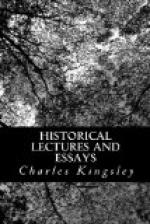These stories are well known to antiquarians. They may be found, almost all of them, in Professor Rafn’s “Antiquitates Americanae.” The action in them stands out often so clear and dramatic, that the internal evidence of historic truth is irresistible. Thorvald, who, when he saw what seems to be, they say, the bluff head of Alderton at the south-east end of Boston Bay, said, “Here should I like to dwell,” and, shot by an Esquimaux arrow, bade bury him on that place, with a cross at his head and a cross at his feet, and call the place Cross Ness for evermore; Gudrida, the magnificent widow, who wins hearts and sees strange deeds from Iceland to Greenland, and Greenland to Vinland and back, and at last, worn out and sad, goes off on a pilgrimage to Rome; Helgi and Finnbogi, the Norwegians, who, like our Arctic voyagers in after times, devise all sorts of sports and games to keep the men in humour during the long winter at Hope; and last, but not least, the terrible Freydisa, who, when the Norse are seized with a sudden panic at the Esquimaux and flee from them, as they had three weeks before fled from Thorfinn’s bellowing bull, turns, when so weak that she cannot escape, single-handed on the savages, and catching up a slain man’s sword, puts them all to flight with her fierce visage and fierce cries—Freydisa the Terrible, who, in another voyage, persuades her husband to fall on Helgi and Finnbogi, when asleep, and murder them and all their men; and then, when he will not murder the five women too, takes up an axe and slays them all herself, and getting back to Greenland, when the dark and unexplained tale comes out, lives unpunished, but abhorred henceforth. All these folks, I say, are no phantoms, but realities; at least, if I can judge of internal evidence.
But beyond them, and hovering on the verge of Mythus and Fairyland, there is a ballad called “Finn the Fair,” and how
An upland Earl had twa braw sons,
My story to begin;
The tane was Light Haldane the strong,
The tither was
winsome Finn.
and so forth; which was still sung, with other “rimur,” or ballads, in the Faroes, at the end of the last century. Professor Rafn has inserted it, because it talks of Vinland as a well-known place, and because the brothers are sent by the princess to slay American kings; but that Rime has another value. It is of a beauty so perfect, and yet so like the old Scotch ballads in its heroic conception of love, and in all its forms and its qualities, that it is one proof more, to any student of early European poetry, that we and these old Norsemen are men of the same blood.




